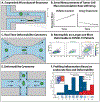Reciprocity of Cell Mechanics with Extracellular Stimuli: Emerging Opportunities for Translational Medicine
- PMID: 35319155
- PMCID: PMC9463119
- DOI: 10.1002/smll.202107305
Reciprocity of Cell Mechanics with Extracellular Stimuli: Emerging Opportunities for Translational Medicine
Abstract
Human cells encounter dynamic mechanical cues in healthy and diseased tissues, which regulate their molecular and biophysical phenotype, including intracellular mechanics as well as force generation. Recent developments in bio/nanomaterials and microfluidics permit exquisitely sensitive measurements of cell mechanics, as well as spatiotemporal control over external mechanical stimuli to regulate cell behavior. In this review, the mechanobiology of cells interacting bidirectionally with their surrounding microenvironment, and the potential relevance for translational medicine are considered. Key fundamental concepts underlying the mechanics of living cells as well as the extracelluar matrix are first introduced. Then the authors consider case studies based on 1) microfluidic measurements of nonadherent cell deformability, 2) cell migration on micro/nano-topographies, 3) traction measurements of cells in three-dimensional (3D) matrix, 4) mechanical programming of organoid morphogenesis, as well as 5) active mechanical stimuli for potential therapeutics. These examples highlight the promise of disease diagnosis using mechanical measurements, a systems-level understanding linking molecular with biophysical phenotype, as well as therapies based on mechanical perturbations. This review concludes with a critical discussion of these emerging technologies and future directions at the interface of engineering, biology, and medicine.
Keywords: biomaterials; cell mechanics; deformability cytometry; directed migration; extracellular matrix; mechanobiology; microfluidics; traction force microscopy.
© 2022 Wiley-VCH GmbH.
Figures








Similar articles
-
Translational mechanobiology: Designing synthetic hydrogel matrices for improved in vitro models and cell-based therapies.Acta Biomater. 2019 Aug;94:97-111. doi: 10.1016/j.actbio.2019.05.055. Epub 2019 May 24. Acta Biomater. 2019. PMID: 31129361 Review.
-
The matrix environmental and cell mechanical properties regulate cell migration and contribute to the invasive phenotype of cancer cells.Rep Prog Phys. 2019 Jun;82(6):064602. doi: 10.1088/1361-6633/ab1628. Epub 2019 Apr 4. Rep Prog Phys. 2019. PMID: 30947151 Review.
-
Extracellular matrix mechanobiology in cancer cell migration.Acta Biomater. 2023 Jun;163:351-364. doi: 10.1016/j.actbio.2022.10.016. Epub 2022 Oct 13. Acta Biomater. 2023. PMID: 36243367 Review.
-
Traction Force Microscopy for Noninvasive Imaging of Cell Forces.Adv Exp Med Biol. 2018;1092:319-349. doi: 10.1007/978-3-319-95294-9_15. Adv Exp Med Biol. 2018. PMID: 30368759 Free PMC article. Review.
-
Integrated micro/nanoengineered functional biomaterials for cell mechanics and mechanobiology: a materials perspective.Adv Mater. 2014 Mar 12;26(10):1494-533. doi: 10.1002/adma.201304431. Epub 2013 Dec 12. Adv Mater. 2014. PMID: 24339188 Free PMC article. Review.
Cited by
-
Nanotopographical cues for regulation of macrophages and osteoclasts: emerging opportunities for osseointegration.J Nanobiotechnology. 2022 Dec 3;20(1):510. doi: 10.1186/s12951-022-01721-1. J Nanobiotechnology. 2022. PMID: 36463225 Free PMC article. Review.
-
A Benzodiazepine-Derived Molecule That Interferes with the Bio-Mechanical Properties of Glioblastoma-Astrocytoma Cells Altering Their Proliferation and Migration.Int J Mol Sci. 2025 Mar 19;26(6):2767. doi: 10.3390/ijms26062767. Int J Mol Sci. 2025. PMID: 40141408 Free PMC article.
-
Mechanical Cell Reprogramming on Tissue-Mimicking Hydrogels for Cancer Cell Transdifferentiation.Research (Wash D C). 2025 Aug 18;8:0810. doi: 10.34133/research.0810. eCollection 2025. Research (Wash D C). 2025. PMID: 40832480 Free PMC article.
-
Spatially defined microenvironment for engineering organoids.Biophys Rev (Melville). 2024 Oct 18;5(4):041302. doi: 10.1063/5.0198848. eCollection 2024 Dec. Biophys Rev (Melville). 2024. PMID: 39679203 Review.
References
-
- Jacobs CR, Huang H, Kwon RY, Introduction to cell mechanics and mechanobiology, Garland Science, 2012.
-
- D’Arcy WT, Dover, New York, 1992.
-
- Kechagia JZ, Ivaska J, Roca-Cusachs P, Nature Reviews Molecular Cell Biology 2019, 20, 457. - PubMed
Publication types
MeSH terms
Grants and funding
LinkOut - more resources
Full Text Sources

